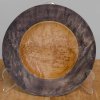Hello all,
I hope you and your collective wisdom can give me some help with this platter- View attachment 7629.
It is 10" and I used black leather dye on the rim. I'm thinking I will gold leaf a reveal between the black and the dished area, but the black is just not doing it for me. Any suggestions for making this thing better?
Thanks,
Chris
I hope you and your collective wisdom can give me some help with this platter- View attachment 7629.
It is 10" and I used black leather dye on the rim. I'm thinking I will gold leaf a reveal between the black and the dished area, but the black is just not doing it for me. Any suggestions for making this thing better?
Thanks,
Chris

